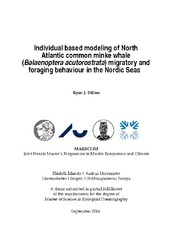| dc.description.abstract | The North Atlantic common minke whale (Balaenoptera Acutorostrata) is an abundant, top-level marine predator in the Nordic Seas and Barents Sea ecosystems whose large-scale migratory and foraging behaviors are widely unknown. Understanding these behaviors may offer important insight into their life-history and management-unit structuring as defined by the International Whaling Commission. Existing modeling do not incorporate spatially-explicit movements of individual minkes, limiting our ability to investigate their large- scale behaviors. In this study, an individual based model (IBM) for minke whales is developed as an extension of the NORWECOM.E2E ecosystem model to identify behaviors that may contribute to minke distribution in the Nordic Seas. The energetic reward of both their use of migration within predominant currents and four large-scale foraging strategies are investigated. First, the effect on minke migration from ocean circulation and migration path selection are tested by running simulations with variation in activation of currents and paths (into and out of the Nordic Seas) along the Norwegian coast, the Norwegian Sea center, and the Greenland coast. Simulations are then run with variation in foraging strategies: random-walk, migration only, and periodic searching for maximum prey density with either random-walk or migration along the route determined to be optimal. NORWECOM.E2E model output of Norwegian spring-spawning herring, blue whiting, and mackerel are used as prey-fields. The optimal migration route is found to be in along the Norwegian coast and out through the Norwegian Sea center, with mean migration durations of 24.611 ± 0.051 d and 24.997 ± 0.041 d. Foraging that incorporates migration and 10 d periods of maximum prey density searching is found to have the highest foraging efficiency index (2.381 ± 0.435). Random- walk movement with maximum prey density searching had similarly high in- dex (2.256 ± 0.444), along with an increase in mean individual whale movement of 14.159 km d^_1 whale^_1 . The development of a minke IBM is an important addition of a high-level predator in Nordic Seas and Barents Sea modeling efforts, and the results from this study could have implications for minke population structuring and success in these areas. With migration throughout the Nordic Seas being energetically viable, interaction between whales categorized as separate sub-stocks could be possible. As an unvalidated model with key improvements necessary, further development of individual based modeling of minkes with more dynamic data is encouraged. | en_US |
